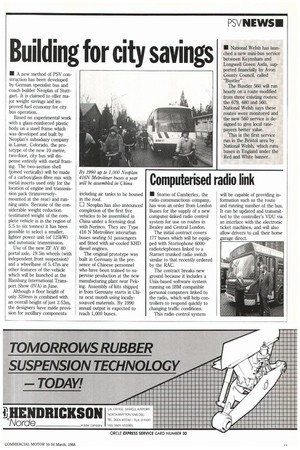Building for city savings • A new method of PSV
Page 23

If you've noticed an error in this article please click here to report it so we can fix it.
construction has been developed by German specialist bus and coach builder Neoplan of Stuttgart. It is claimed to offer major weight savings and improved fuel economy for city bus operation.
Based on experimental work with a glass-reinforced plastic body on a steel frame which was developed and built by Neaplan's subsidiary company in Lamar, Colorado, the prototype of the new 10 metre, two-door, city bus will dispense entirely with metal framing. The two-section shell (joined vertically) will be made of a carbon/glass-fibre mix with metal inserts used only for the location of engine and transmission pack (transverselymounted at the rear) and running units. Because of the considerable weight reduction (estimated weight of the complete vehicle is in the region of 5.5 to six tonnes) it has been possible to select a smaller, lighter power unit (of 125kW) and automatic transmission.
Use of the new ZF AV 80 portal axle, 19.5in wheels (with independent front suspension) and a wheelbase of 5.47m are other features of the vehicle which will be launched at the Hamburg International Transport Show (IVA) in June.
Although a floor height of only 320mm is combined with an overall height of just 2.53m, the designers have made provision for auxiliary components including air tanks to be housed in the roof.
Neoplan has also announced completion of the first five vehicles to be assembled in China under a licensing deal with Norinco. They are Type 416 N Metroliner interurban buses seating 51 passengers and fitted with air-cooled KHD diesel engines.
The original prototype was built in Germany in the presence of Chinese personnel who have been trained to supervise production at the new manufacturing plant near Peking. Assembly of kits shipped in from Germany starts in China next month using locallysourced materials. By 1990 annual output is expected to reach 1,000 buses.








































































































